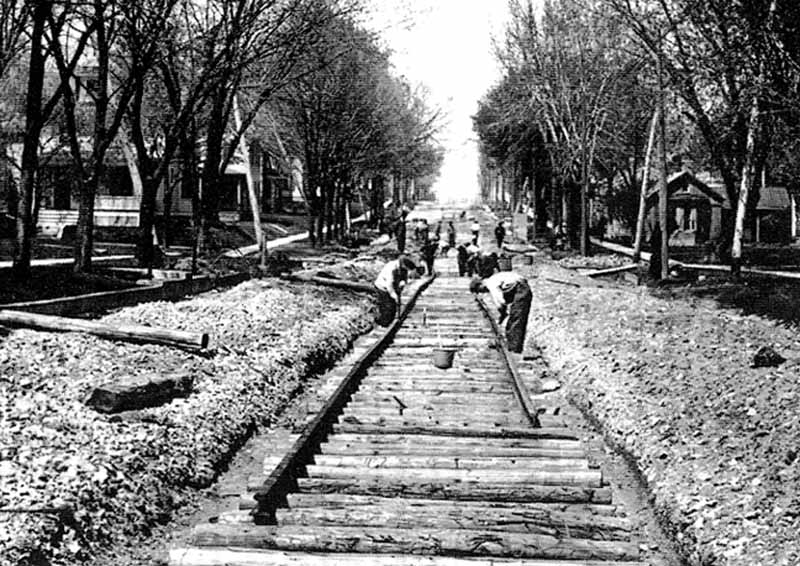
Intense hand labor is applied during 1910 to install streetcar tracks in North Dubuque Street
between Fairchild Street (foreground) and Church Street (on horizon).
Five local trolley lines served Iowa City from 1909 until buses took over in 1931.
Photo courtesy Carolyn Boerner.
|
By
Bob Hibbs
Amid
band music and applause from “an immense throng,” a silver spike was
ceremonially driven Nov. 17, 1909 at Clinton and College streets to mark
inauguration of trolley service in Iowa City.
The
fare was a nickel; a large sum considering that young Emery Kelley earned just
a dime a week back then cleaning the trolley shelter at Muscatine Avenue and
Rundell Street. A nickel would buy a dip of ice cream or a cherry coke at
Whetstone’s Drug.
The
first line ran just 18 blocks, five along College to Johnson, a block south to
Burlington, seven east to Muscatine Avenue, two southeast to Rundell and three
south to just beyond Sheridan Avenue where a streetcar barn backed onto
Ralston Creek.
Opening
marked culmination of two decades of efforts beginning when the city offered a
50-year franchise in 1891, though nothing materialized. An 1893 proposal also
died without tracks. In 1909 Mayor Ralph Otto was assisted by Commercial Club
Pres. Roscoe Ayres and others in inaugurating service.
UI
engineering college Prof. Byron Lambert, who designed the route, operated the
small bunting-draped car on its first run. Paperwork was completed the next
year incorporating the Iowa City Electric Railway Co., headed by former
railroad and city engineer Julius Schultz, and including brother-in-law J.H.
Rohret, G.A. Sueppel and James Maggard.
Schultz
also headed Rundell Land Improvement Co. which was offering 270 lots in its
new Rundell Addition located between Oakland Street and the decade-old East
Iowa City subdivision’s Seventh Avenue.
The
service would help sell lots, as well as serve the 1899 W.F. Main Co.
jewelry factory located just three blocks to the east at the heart of
East Iowa City. That factory burned Sunday, Dec. 12, 1937, then a seed corn
warehouse.
Local
street cars were a separate operation from the 27-mile Crandic Railway’s
“interurban” passenger service offered between Iowa City and Cedar Rapids
from 1904 into 1953.
During
1910 street car tracks were extended north in Dubuque Street, resulting in
moving the first local fountain from its Dubuque-Iowa Avenue site into a pond
in City Park. Tracks turned east along Church Street to Dodge, then northeast
to Conklin Lane, where a triangular intersection today marks the end of that
21-block line, opened in 1911.
Three
subsequent extensions ran tracks 17 blocks to Oakland Cemetery via Washington,
Van Buren, Jefferson, Governor, Bloomington and Center streets, five blocks on
Clinton Street to the Rock Island depot, and 14 blocks across Park Road bridge
into Manville Heights via Park Road and Ferson Avenue to a shelter at River
Street.
That
last route fostered a battle with Belle Vista Place neighbors who objected to
construction of a second crossing of the Iowa River immediately upstream from
the 1908 Park Road span. Compromise eventually put the tracks on the existing
bridge while trusses for the proposed span rusted on the river bank.
Two
open-topped rail cars offered stylish summer service to City Park.
The
Rundell Street barn was replaced in 1921 by one on the Washington Street site
of the Press-Citizen’s 1937 art-deco building, which was sold in 1991 and
now is offices and apartments. The central passenger transfer point was moved
about 1913 from the Crandic Depot corner to the Hotel Jefferson corner.
Tokens
became the medium of rider payments in 1924 and 1925.
The
trolley system was purchased by Mississippi Utilities in 1914, and dwindling
ridership forced bankruptcy in 1928. It was purchased by local lawyer Henry
Negus, whose son Joseph and grandson Lewis converted to buses and operated
until conversion to city-run service in 1971.
Today
city buses traverse 17 routes along 124 miles, reports City Transit Director
Ron Logsden. That contrasts with five trolley routes totaling six miles in
1915, quite an evolution during nearly a century.
Next
Saturday:
A curious platform tops downtown pole about 1910. Bob Hibbs collects local postcards and researches history related to them. |